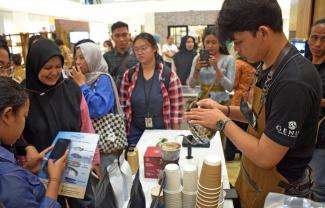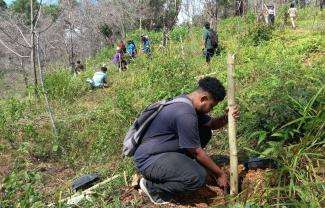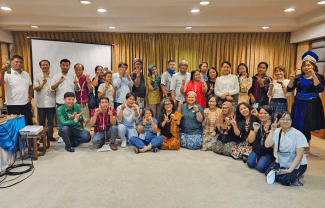PALAWAN, Philippines - Civil society groups and government units working in the town of Coron in Palawan province are using indigenous peoples' (IP) old knowledge on the environment and disasters to ensure their communities are climate change resilient.
When Super Typhoon Yolanda (Haiyan) battered the resort town of Coron in November 2013, international aid groups and non-governmental organizations rushed to help.
“There were more than 10 NGOs that came in after Yolanda. But most of them used the dole-out system so most of the communities got used to just receiving assistance without relying on their own capacity,†said Shane Naguit, community facilitator of Samdhana Institute, an international NGO focused on helping IPs in the Philippines and Indonesia.
This was not sustainable, Naguit added, especially after the relief and recovery phase ended.
The Catholic Organization for Relief and Development Aid (CordAid) saw the need to make indigenous communities resilient. After its Yolanda recovery and rebuilding operations ended in 2015, it focused on building a development program to ensure resiliency in recovering communities. This is how Samdhana came in.
“We assisted the (indigenous) communities to develop a disaster risk reduction (DRR) plan by themselves. They developed it based on their own knowledge because they have been here in the area for so long. They know the area and they know how to best respond to disasters,†Naguit added.
She added: “They have an indigenous structure that is more resilient to typhoons compared to the models that were introduced by other agencies…We looked at the indigenous political structures of the communities so we didn't have to form any new organization.â€
Value of old knowledge
According to the National Commission on Indigenous Peoples (NCIP) in Coron, the Tagbanuas in the Calamian Islands were the worst affected by the super typhoon. Many families lost their livelihoods and their homes.
Despite this, the Tagbanuas continued to thrive even before help came.
“During Yolanda, it took more than 3 weeks before some IP villages got their share of relief goods. The IPs survived without food supplies. Their indigenous ways helped them survive,†Conrado Balbutan, NCIP tribal affairs assistant, told Rappler.
He added: “It's important to teach them new systems but still utilize their old knowledge. Like in livelihood, new systems gave them the perspective that they shouldn't only harvest, but that they should make the land sustainable. It deepened their old knowledge about nature.â€
Such is the case for Barangay Malawig in Coron. The organizations created livelihood programs that introduced farming new crops in the community but still utilized the old crops.
“An example we saw in the community was that they have an indigenous crop called ‘kurot.' This root crop can withstand typhoons and long dry seasons. It's a very resilient crop that helps ensure food security in the community,†Naguit said.
Before the intervention, malnutrition was rampant in Malawig. With the introduction of new crops and community gardens, residents of the community are now living healthier lives.
Balbutan noted that the interventions by CordAid and Samdhana were important because they didn't just impose programs, but they made sure that they'd prepare the IP communities for future typhoons.
More lessons from Yolanda
The super typhoon was a wake up call for the municipal government. Though less publicized, Coron sustained the most damage from Yolanda with 6,000 evacuees displaced during the onslaught. Of the 1,000 tourist boats registered then, only 10 remained. (WATCH: Coron remembers Yolanda as it recovers)
This is why the Municipal Disaster Risk Reduction and Management Office (MDRRMO) is now taking a proactive stance.
“We've had several trainings on the Incident Command System (ICS) for our barangays last December 2017 because we wanted to be prepared how to manage a disaster. We're also asking all our barangays to update or create their contingency plans,†newly-appointed MDRRMO chief Fernando Lopez said.
The local government has also purchased early warning systems - sirens and radios - to be given to every barangay.
Lopez, whose own house was destroyed by Yolanda, said the town easily recovered from the typhoon because of the support of organizations like CordAid.
“The communities easily recovered because of the outpouring of support from NGOs - from the houses they built to the water systems they fixed. We're very grateful to them,†Lopez added.
Miss Universe visit
On Saturday, January 20, reigning Miss Universe Pia Wurtzbach is set to visit Barangay Malawig to hear the experiences of the Tagbanuas during Yolanda.
"This will really empower our IP communities. They really appreciate this gesture - that the reigning Miss Universe will see their situation in their remote area," Naguit said.
The Miss Universe Foundation is a partner of CordAid and the Caritas network.
Source : â€How Tagbanua communities in coron recovered from Yolandaâ€. Rappler.com, January 22, 2017




